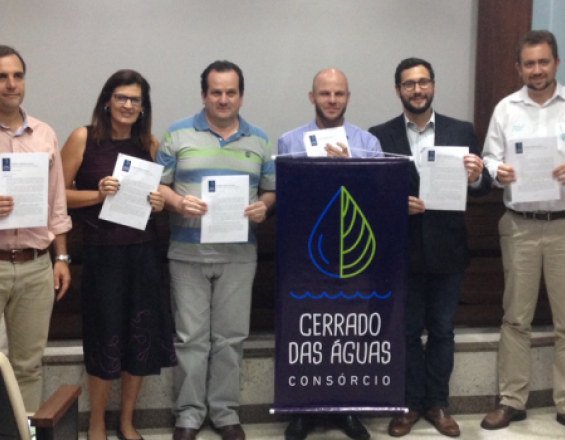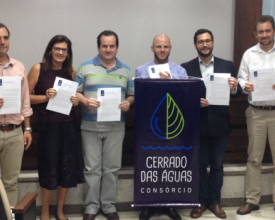
Consórcio Cerrado das Aguas (Consorcio de las Aguas del Cerrado) - fomento del café y la conservación

El Consorcio Aguas del Cerrado reúne a caficultores, productores, investigadores y ecologistas para mantener los servicios ecosistémicos de los que dependen las cadenas de suministro agrícola, incluido el café. Se centra en la conservación y restauración de la vegetación autóctona del estado brasileño de Minas Gerais para salvaguardar el suministro de agua. El Cerrado, en las llanuras del altiplano central del país, es una importante fuente de agua para Brasil.
El consorcio trabaja con las partes interesadas de toda la cadena de suministro del café, centrándose inicialmente en un lugar piloto: la cuenca de Feio, en Patrocinio, una importante zona cafetera. Se está trabajando para mejorar la gestión del suelo y el agua, promover el intercambio de información y conocimientos mediante servicios de divulgación para los agricultores y fomentar el cumplimiento de la legislación en las explotaciones, incluida la aplicación del Código Forestal brasileño a nivel de paisaje.
Contexto
Défis à relever
El Cerrado alberga agroindustrias de éxito, pero varios factores medioambientales amenazan la sostenibilidad a largo plazo de la región. El café de calidad se produce a gran escala y las explotaciones tienen un alto nivel de certificación. Pero los productores de café se enfrentarán a muchos retos, el principal de los cuales es la disminución del suministro de agua.
La pérdida de vegetación y la erosión del suelo amenazan servicios ecosistémicos como la regulación del agua, la polinización y la regulación del clima. Los productores de café son conscientes de la importancia de los ecosistemas para la productividad y están preocupados por el impacto ambiental, pero han actuado a nivel de explotación.
Tras su fase inicial, el consorcio necesita financiación para lograr un enfoque integrado de la gestión del paisaje y las prácticas agrícolas. Esto incluiría la ampliación de los trabajos de conservación y restauración al menos a otras seis cuencas hidrográficas (que abarcan el 70% de la producción de café) y la movilización de los productores de la región para poner en práctica la visión del consorcio.
Ubicación
Procesar
Resumen del proceso
Los componentes básicos se combinan como una estructura para pilotar la acción colectiva que constituye una base fundamental para la expansión y reproducción del consorcio. Esta estructura ayuda a gestionar el conocimiento generado, aprovechar las lecciones aprendidas y comprender los patrones entre las distintas acciones.
La plataforma se enfrenta a un reto complejo dado que esta región incluye 55 municipios y miles de intereses diferentes. El primer bloque de construcción aborda la necesidad de un equipo legítimo, articulado y relevante de instituciones estratégicamente interesadas en la región, para definir una visión común. El consorcio tuvo la suerte de ser fundado por actores internacionales sólidos como la UICN y Nespresso. La asociación entre un actor del sector privado que tiene un interés económico en la conservación de la zona debido a un riesgo en la cadena de suministro y una organización medioambiental internacional líder hizo que la plataforma fuera influyente desde el principio. Se hicieron esfuerzos concertados para garantizar que la plataforma incluyera voces representativas de toda la región.
Para que la plataforma crezca y alcance todo su potencial, es importante que cuente con un plan de acción claro y una estructura de gobernanza lo bastante sólida para expandirse.
Bloques de construcción
Combinar la experiencia internacional con los conocimientos sobre el terreno
El consorcio ha hecho un esfuerzo concertado para aprovechar el trabajo existente en lugar de duplicarlo. Algunos miembros llevan 15 años trabajando en la región y han acumulado una gran experiencia. Esta experiencia se combina ahora con los conocimientos nacionales e internacionales de otros miembros para orientar la coordinación estratégica de las actividades.
Se están formando nuevas asociaciones a todos los niveles y se está compartiendo información entre diversos agentes. Los que tienen conocimientos técnicos o científicos se están asociando con ONG que tienen la voluntad y la capacidad de generar cambios. Un ejemplo es que la UICN ayudará a la ONG local Imaflora a desarrollar indicadores de biodiversidad para el manual del consorcio sobre conservación y mejores prácticas agrícolas. La UICN también ha movilizado a las principales marcas de café (Lavazza, Illy y Nestlé) junto con Nespresso para discutir una posible colaboración para ampliar el consorcio.
Factores facilitadores
- Capacidad para mapear a todas las partes interesadas presentes en la zona e interesadas en participar, para construir una plataforma que sea legítima, representativa y capaz de implementar el cambio.
Lección aprendida
Se han aprovechado varias lecciones valiosas. Entre ellas cabe destacar:
- Comprender todos los intereses y partes interesadas de una región determinada;
- Contar con patrocinadores internacionales que puedan aportar su experiencia a la plataforma;
- Contar con organizaciones locales que trabajen en la región y tengan una trayectoria consolidada y exitosa;
- Utilizar la cocreación como enfoque principal para definir la estrategia y los planes de acción.
Aunque el impulso inicial partió de una empresa, Nespresso, el consorcio utiliza un enfoque sectorial, con el objetivo último de cambiar el comportamiento de toda la cadena de suministro de café. Un enfoque sectorial promueve un cambio más potente, envía una señal clara al mercado y garantiza la sostenibilidad del consorcio.
Plan de acción y presupuesto detallados
La visión del consorcio se ha transformado en un plan de acción claro con líneas de trabajo específicas, acompañado de un presupuesto detallado:
- Paisajes conectados
- Prácticas agrícolas respetuosas con el clima
- Recursos hídricos garantizados
- Compromiso de las partes interesadas
- Recaudación de fondos
El plan de acción se basa en una evaluación exhaustiva basada en imágenes por satélite y entrevistas con cada propietario o productor de la zona. Se celebraron amplias consultas con todas las partes implicadas y potencialmente afectadas por las intervenciones (agricultores, miembros, organismos gubernamentales y donantes). El plan incluye detalles sobre quién hará qué y cuándo, lo que es clave para supervisar los avances respecto a los objetivos generales. Todo ello tranquiliza a donantes e inversores, que pueden comprobar que su financiación se orienta eficazmente.
Factores facilitadores
- Claridad sobre la visión del grupo y los objetivos de cada línea de trabajo.
- Una larga y profunda fase de preparación que reúna un conocimiento detallado de cada bien.
Lección aprendida
Al tratarse de una iniciativa pionera en expansión, es necesario realizar ajustes para garantizar una fase de aplicación fluida y unos resultados concretos de los que el grupo pueda aprender. Hasta la fecha, el consorcio se ha centrado en acciones a corto plazo y objetivos inmediatos.
Para atraer a más donantes y socios, el consorcio ha elaborado un plan de acción con objetivos concretos, al tiempo que aborda los costes y los socios potenciales de cada actividad.
Estructura de gobierno sólida e independiente
El modelo de gobernanza del consorcio será diferente al de las mayores plataformas de sostenibilidad, que reúnen a diversas partes interesadas. Se compone de un consejo, un fondo de innovación, comités, un equipo de gestión y socios ejecutores, cada uno con un papel claro. Esto ayuda a reducir el riesgo de conflictos de intereses. Los intereses de sostenibilidad sobre el terreno impulsan la plataforma en lugar de la competencia por la financiación, los mandatos y la influencia. El equipo de gestión coordina la ejecución del plan de acción y supervisa su impacto. Se celebran reuniones periódicas para garantizar la coherencia entre los socios y que las líneas de trabajo avancen hacia los objetivos y la visión generales.
Factores facilitadores
Un elemento clave del éxito del consorcio es que, si bien la estrategia la diseñan los miembros del consejo, que velan por el interés a largo plazo en el futuro y la prosperidad de la región, la ejecución correrá a cargo de especialistas y la coordinará un equipo de gestión.
Lección aprendida
Para reproducir y ampliar las acciones de la plataforma es importante contar con una estructura de gobernanza con miembros del consejo que no sean directamente responsables de la aplicación para evitar conflictos de intereses.
Cuando las acciones sobre el terreno están coordinadas por un equipo de gestión profesional y no por organizaciones aisladas, este equipo puede aprender, replicar el trabajo y comunicar los resultados de forma más eficaz durante la expansión de la plataforma.
Impactos
- El consorcio está impulsando la acción desde las explotaciones hasta el paisaje. Ahora hay objetivos compartidos y esfuerzos coordinados: la presión de los pares anima a todos a actuar.
- El intercambio de información y el desarrollo de capacidades están reforzando las acciones en curso para hacer frente a la escasez de agua y el agotamiento de los recursos naturales.
- Hay un cambio de actitud y comportamiento entre la comunidad hacia la sostenibilidad y una mejor comprensión de las amenazas comunes a los servicios ecosistémicos, así como de los valores de conservación prioritarios.
- El consorcio ha conseguido 190.000 USD para ejecutar actividades clave en 2018 y 2019 con el Fondo de Alianzas para los Ecosistemas Críticos (CEPF).
Los impactos pueden agruparse de la siguiente manera:
Paisajes sostenibles
- Rehabilitación de zonas degradadas
- Ordenación territorial para la estrategia de conservación
- Restauración del paisaje
- Mantenimiento de los servicios ecosistémicos
Conocimientos y buenas prácticas
- Formación
- Asistencia técnica
- Sensibilización
- Desarrollo de capacidades
- Seguimiento de indicadores
Cadenas de suministro sostenibles
- Cumplimiento de la legislación medioambiental
- Diferenciación competitiva/denominación de origen
- Certificación
Beneficiarios
Cafeteros, productores de café y comunidades locales.
Objetivos de Desarrollo Sostenible
Historia
"El agua de hoy es el resultado de los paisajes que construimos".
Declaración de la visión del Consorcio Aguas del Cerrado
El municipio de Patrocinio, en la región de Cerrado, es una de las principales zonas productoras de café de Brasil. Su principal fuente de agua es la cuenca del Feio, afluente del río Dourados que desemboca a su vez en el río Paranaiba, abasteciendo a 193 municipios, una parte importante de la población brasileña.
Entre 1970 y 1980, la cuenca del Feio sufrió una intensa transformación debido a la ganadería y la producción de cereales y café. Pero con el tiempo las explotaciones de café se han profesionalizado y han mejorado la gestión de sus tierras para garantizar mejores condiciones a las generaciones futuras.
Los agricultores han adoptado técnicas adecuadas de gestión del suelo, restaurado zonas degradadas, ayudado a conservar áreas protegidas y protegido las fuentes de agua de la zona.
Sin embargo, es necesario seguir actuando, ya que la escasez de agua en la región se ha hecho más frecuente en los últimos años. Aumentar la concienciación, fomentar las buenas prácticas y concertar los esfuerzos de restauración pueden ayudar a salvaguardar la cuenca.
El Consorcio Aguas del Cerrado eligió la cuenca del Feio para su primer proyecto piloto, con vistas a ampliar el modelo a otras cuencas.
Este compromiso innovador ha demostrado ser una opción viable para construir un nuevo modelo centrado en soluciones a largo plazo en la región del Cerrado y tiene el potencial de inspirar a otros agentes dispuestos a dar un paso adelante para marcar la diferencia.


